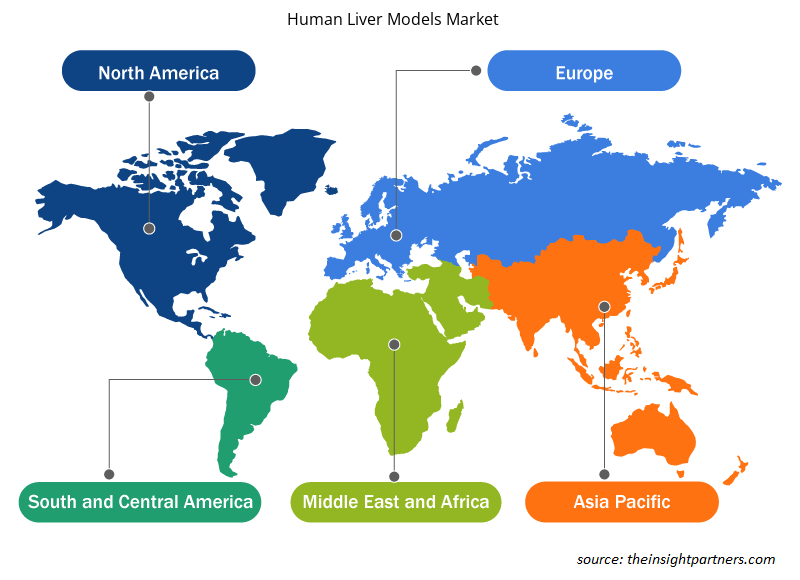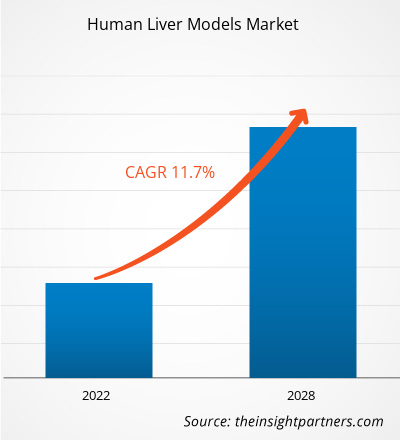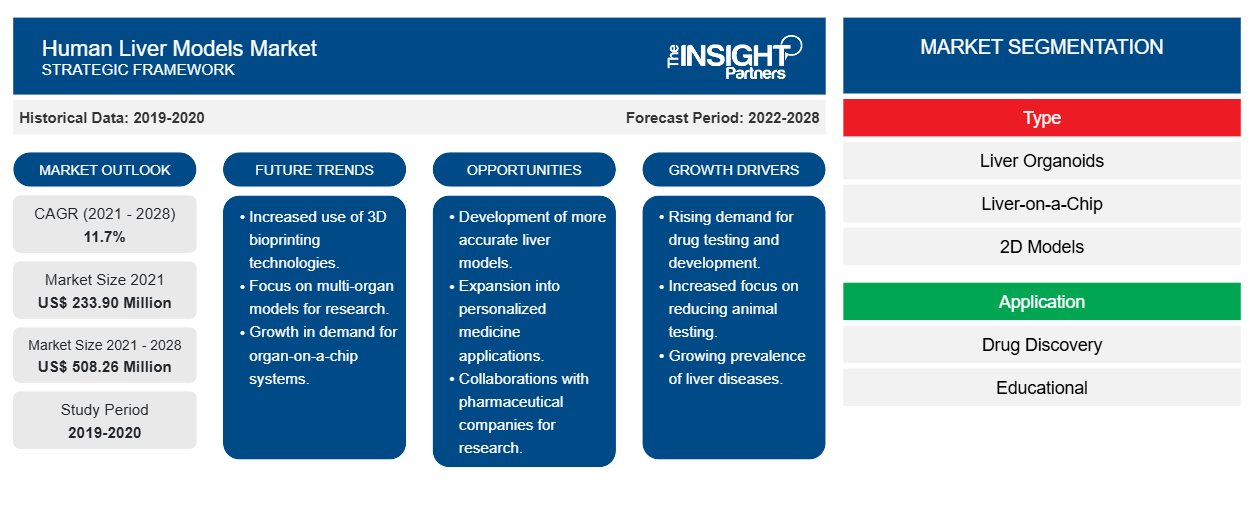Le marché des modèles de foie humain devrait atteindre 508,26 millions de dollars américains d'ici 2028, contre 233,90 millions de dollars américains en 2021 ; il devrait croître à un TCAC de 11,7 % de 2021 à 2028.CAGR of 11.7% from 2021 to 2028.
La croissance du marché est principalement attribuée à la prévalence croissante des maladies du foie et à l'accent croissant mis sur le développement d'alternatives aux modèles d'expérimentation animale. Cependant, les coûts élevés des modèles de foie humain et les problèmes liés à l'intégration des modèles de foie dans le flux de travail existant entravent la croissance du marché des modèles de foie humain . Le foie est un organe important qui remplit des fonctions corporelles vitales telles que la synthèse des facteurs de coagulation sanguine, la production de bile, la production de protéines et la détoxification. Les modèles de foie humain sont utilisés pour étudier la toxicité des médicaments et permettre de comprendre l'effet des médicaments et la progression des maladies du foie. L'accent croissant mis sur le développement d'alternatives aux modèles d'expérimentation animale est l'un des principaux facteurs qui devraient encourager la croissance des modèles de foie humain mondiaux au cours des prochaines années.
L'industrie biopharmaceutique de la région Asie-Pacifique a été perturbée pendant quelques mois en 2020 en raison de l'épidémie de COVID-19. La pandémie de COVID-19 a eu des répercussions sans précédent sur les essais cliniques en raison des multiples niveaux de restrictions imposées pour contrôler la propagation de l'infection. Cependant, avec la demande croissante de produits pour traiter l'infection par le COVID-19, les sociétés biopharmaceutiques et pharmaceutiques en Inde et en Chine ont augmenté leurs activités de recherche, ce qui a un impact positif sur la croissance du marché.
Personnalisez ce rapport en fonction de vos besoins
Vous bénéficierez d'une personnalisation gratuite de n'importe quel rapport, y compris de certaines parties de ce rapport, d'une analyse au niveau des pays, d'un pack de données Excel, ainsi que de superbes offres et réductions pour les start-ups et les universités.
-
Obtenez les principales tendances clés du marché de ce rapport.Cet échantillon GRATUIT comprendra une analyse de données, allant des tendances du marché aux estimations et prévisions.
Informations sur le marché
La prévalence croissante des maladies du foie stimule la croissance du marché des modèles hépatiques humains
Le foie est le plus grand organe interne du corps humain et remplit plus de 500 fonctions. La toxicité hépatique est une préoccupation majeure dans l'évaluation des risques, car le foie est exposé à la plupart des composés xénobiotiques et à leurs métabolites bioactifs, ce qui le rend vulnérable aux maladies hépatiques d'origine chimique. Le virus de l'hépatite C (VHC), le virus de l'hépatite B chronique (VHB), la stéatose hépatique non alcoolique (NAFLD) et la maladie hépatique associée à l'alcool (ALD) sont parmi les principales causes de maladie hépatique chronique. L'hépatite virale continue d'être la principale cause de décès par insuffisance hépatique et, dans le même temps, la NAFLD est devenue l'un des contributeurs à la morbidité hépatique et à la mortalité associée qui connaît la croissance la plus rapide. Selon les statistiques nationales du Royaume-Uni, les maladies du foie sont classées comme la cinquième cause de décès dans le pays.xenobiotic compounds and their bioactive metabolites, making it susceptible to chemically induced liver disease. Hepatitis C virus (HCV), chronic hepatitis B virus (HBV), nonalcoholic fatty liver disease (NAFLD), and alcohol-associated liver disease (ALD) are among the leading causes of chronic liver disease. Viral hepatitis continues to be the leading cause of death cases caused by liver failure, and at the same time, the NAFLD has become one of the fastest-growing contributors to liver morbidity and associated mortality. According to the national statistics of the UK, liver diseases have been ranked the fifth-leading cause of death in the country.
De plus, ces maladies sont considérées comme la deuxième cause de décès parmi toutes les maladies digestives aux États-Unis. Selon l'American Association for the Study of Liver Diseases, en 2017, la charge mondiale du cancer du foie et de la cirrhose a augmenté. La prévalence des NAFLD est estimée à environ 25 % dans la population générale. Près d'un tiers de la population américaine est atteinte de NAFLD, et les personnes atteintes de diabète sucré de type 2 ou d'obésité sont touchées de manière disproportionnée ; le nombre de cas de NAFLD devrait passer de 83,1 millions de personnes en 2015 à 100,9 millions d'ici 2030. Ainsi, une augmentation de la prévalence mondiale des maladies du foie, y compris les maladies chroniques et aiguës et les infections microbiennes, augmente la demande de modèles hépatiques.NAFLDs have an estimated prevalence of ~25% in the general population. Nearly a third of the US population has the NAFLD, and people with Type 2 diabetes mellitus or obesity are disproportionately affected; the number of cases with NAFLD is expected to increase from 83.1 million people in 2015 to 100.9 million by 2030. Thus, a rise in the global prevalence of liver diseases, including chronic and acute diseases and microbial infections, increases the demand for liver models.
Informations basées sur les types
En fonction du type, le marché des modèles de foie humain est encore segmenté en organoïdes hépatiques, foie sur puce, modèles 2D, bio-impression 3D et autres. Le segment des organoïdes hépatiques détient la plus grande part du marché. Cependant, le segment du foie sur puce devrait enregistrer le TCAC le plus élevé au cours de la période 2021-2028. Les progrès de la technologie des organoïdes hépatiques fournissent des modèles pour le développement prénatal, la préservation des tissus et les pathologies, ce qui propulserait la croissance du marché de ce segment dans les années à venir.organoids, liver-on-a-chip, 2D models, 3D bioprinting, and others. The liver organoids segment holds the largest share of the market. However, the liver-on-a-chip segment is anticipated to register the highest CAGR during 2021–2028. Advances in liver organoid technology provide models for prenatal development, tissue preservation, and pathologies, which would propel the market growth of this segment in the coming years.
Informations basées sur les applications
En fonction des applications, le marché des modèles de foie humain est encore segmenté en segments éducatifs, découverte de médicaments et autres. Le segment de la découverte de médicaments détient la plus grande part du marché des modèles de foie humain ; cependant, le segment éducatif devrait enregistrer le TCAC le plus élevé au cours de la période de prévision.CAGR during the forecast period.
Informations basées sur l'utilisateur final
En fonction de l'utilisateur final, le marché des modèles de foie humain est segmenté en instituts de recherche, sociétés pharmaceutiques et biotechnologiques et autres. Le segment des sociétés pharmaceutiques et biotechnologiques détient la plus grande part de marché. Cependant, le segment des instituts de recherche devrait enregistrer le TCAC le plus élevé au cours de la période de prévision. La croissance prévue du marché pour ce segment peut être attribuée à une augmentation des collaborations entre l'industrie et les universités pour la recherche sur le génome et aux avancées technologiques dans la production de modèles de foie humain.
Les entreprises opérant sur le marché des modèles de foie humain adoptent une stratégie d’innovation de produits pour répondre à l’évolution des demandes des clients dans le monde entier, ce qui leur permet également de maintenir leur nom de marque sur le marché mondial.
Aperçu régional du marché des modèles de foie humain
Les tendances régionales et les facteurs influençant le marché des modèles hépatiques humains tout au long de la période de prévision ont été expliqués en détail par les analystes d’Insight Partners. Cette section traite également des segments et de la géographie du marché des modèles hépatiques humains en Amérique du Nord, en Europe, en Asie-Pacifique, au Moyen-Orient et en Afrique, ainsi qu’en Amérique du Sud et en Amérique centrale.

- Obtenez les données régionales spécifiques au marché des modèles de foie humain
Portée du rapport sur le marché des modèles de foie humain
| Attribut de rapport | Détails |
|---|---|
| Taille du marché en 2021 | 233,90 millions de dollars américains |
| Taille du marché d'ici 2028 | 508,26 millions de dollars américains |
| Taux de croissance annuel moyen mondial (2021-2028) | 11,7% |
| Données historiques | 2019-2020 |
| Période de prévision | 2022-2028 |
| Segments couverts |
Par type
|
| Régions et pays couverts |
Amérique du Nord
|
| Leaders du marché et profils d'entreprises clés |
|
Densité des acteurs du marché : comprendre son impact sur la dynamique des entreprises
Le marché des modèles hépatiques humains connaît une croissance rapide, tirée par la demande croissante des utilisateurs finaux en raison de facteurs tels que l'évolution des préférences des consommateurs, les avancées technologiques et une plus grande sensibilisation aux avantages du produit. À mesure que la demande augmente, les entreprises élargissent leurs offres, innovent pour répondre aux besoins des consommateurs et capitalisent sur les tendances émergentes, ce qui alimente davantage la croissance du marché.
La densité des acteurs du marché fait référence à la répartition des entreprises ou des sociétés opérant sur un marché ou un secteur particulier. Elle indique le nombre de concurrents (acteurs du marché) présents sur un marché donné par rapport à sa taille ou à sa valeur marchande totale.
Les principales entreprises opérant sur le marché des modèles de foie humain sont :
- THERMO FISHER SCIENTIFIC INC.
- Émuler, Inc.
- CN Bio Innovations,
- CYLUSE BIOMEDICALE KK
- MIMETAS BV
Avis de non-responsabilité : les sociétés répertoriées ci-dessus ne sont pas classées dans un ordre particulier.

- Obtenez un aperçu des principaux acteurs du marché des modèles hépatiques humains
Marché des modèles de foie humain – par type
- Organoïdes du foie
- Foie sur chips
- Modèles 2D
- Bio-impression 3D
- Autres
Marché des modèles de foie humain – par application
- Découverte de médicaments
- Pédagogique
- Autre
Marché des modèles de foie humain – par utilisateur final
- Sociétés pharmaceutiques et biotechnologiques
- Instituts de recherche
- Autres
Marché des modèles de foie humain – par géographie
-
Amérique du Nord
- NOUS
- Canada
- Mexique
-
Europe
- France
- Allemagne
- Italie
- ROYAUME-UNI
- Espagne
- Reste de l'Europe
-
Asie-Pacifique (APAC)
- Chine
- Inde
- Corée du Sud
- Japon
- Australie
- Reste de l'APAC
-
Moyen-Orient et Afrique (MEA)
- Afrique du Sud
- Arabie Saoudite
- Émirats arabes unis
- Reste de la MEA
-
Amérique du Sud et Amérique centrale (SCAM)
- Brésil
- Argentine
- Reste de SCAM
Profils d'entreprise
- THERMO FISHER SCIENTIFIC INC.
- Émuler, Inc.
- CN Bio Innovations,
- CYLUSE BIOMEDICALE KK
- MIMETAS BV
- Dans Sphéro
- BioIVT
- Lien cellulaire
- Kerafast
- Cyprien
- Kirkstall
- ORGANOVO HOLDINGS INC
- Analyse historique (2 ans), année de base, prévision (7 ans) avec TCAC
- Analyse PEST et SWOT
- Taille du marché Valeur / Volume - Mondial, Régional, Pays
- Industrie et paysage concurrentiel
- Ensemble de données Excel
Rapports récents
Rapports connexes
Témoignages
Raison d'acheter
- Prise de décision éclairée
- Compréhension de la dynamique du marché
- Analyse concurrentielle
- Connaissances clients
- Prévisions de marché
- Atténuation des risques
- Planification stratégique
- Justification des investissements
- Identification des marchés émergents
- Amélioration des stratégies marketing
- Amélioration de l'efficacité opérationnelle
- Alignement sur les tendances réglementaires























 Obtenez un échantillon gratuit pour - Marché des modèles de foie humain
Obtenez un échantillon gratuit pour - Marché des modèles de foie humain